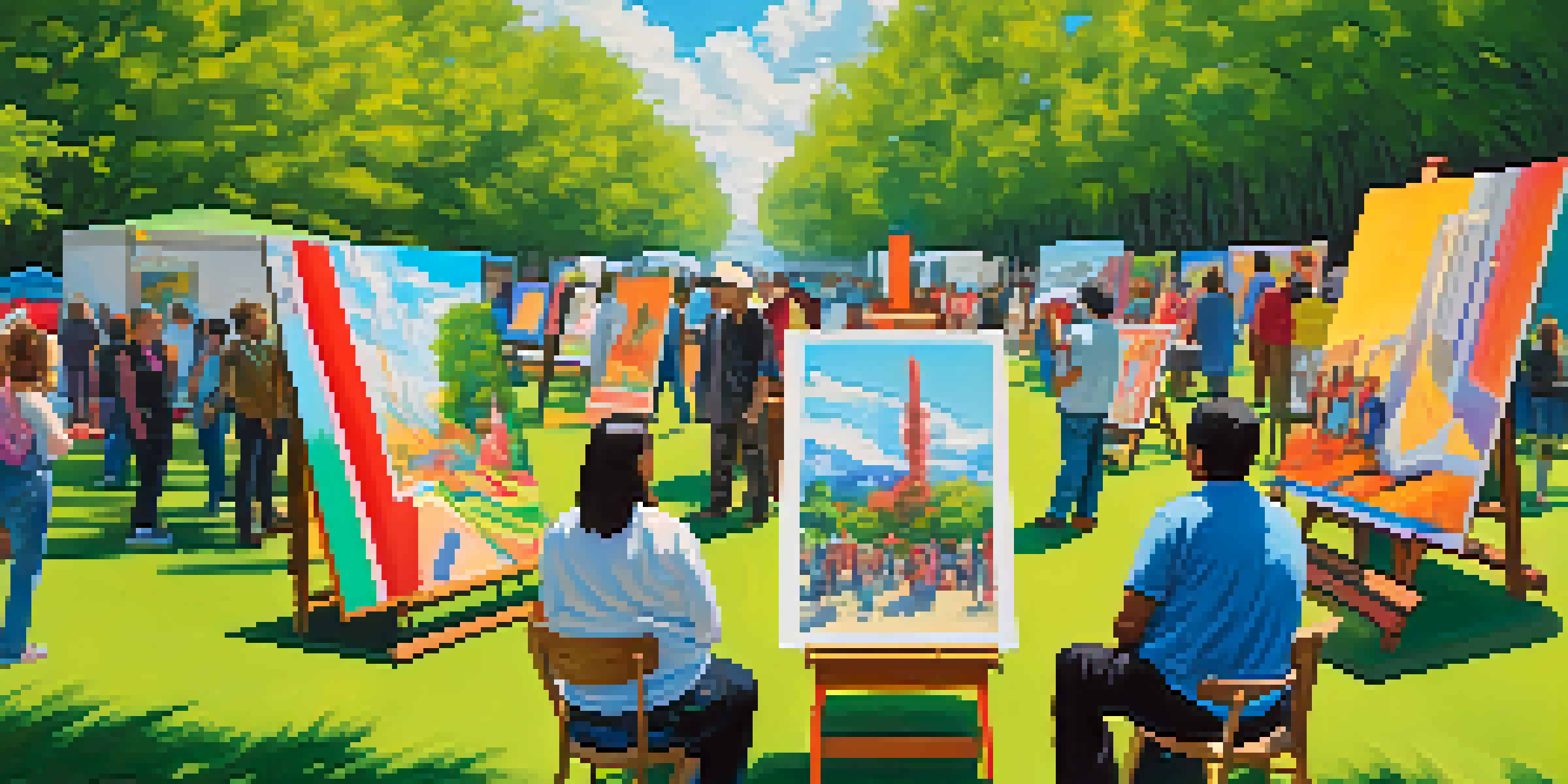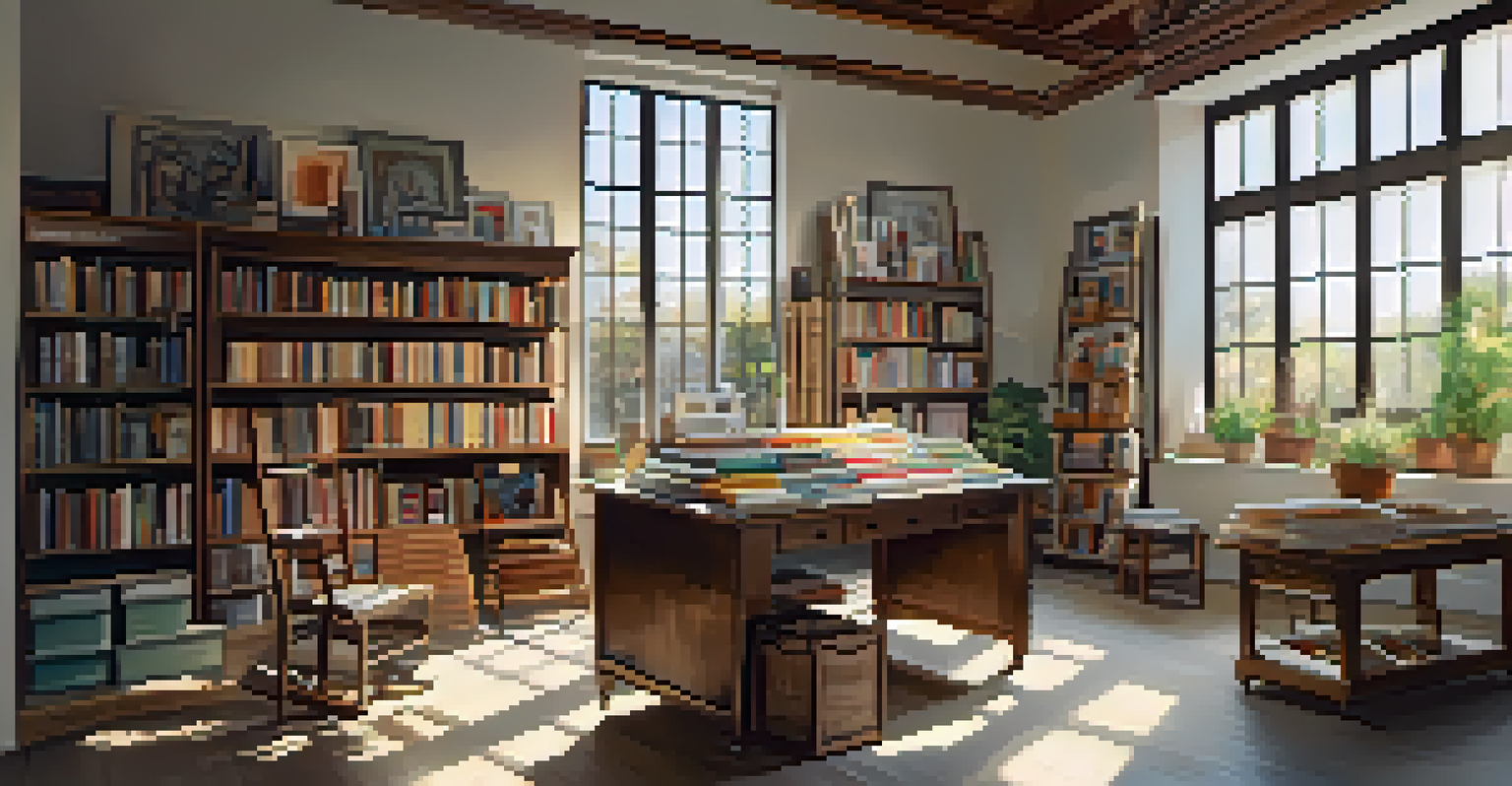Cultural Identity in Modern Painting: A Global Perspective

Understanding Cultural Identity in Art
Cultural identity in art refers to the ways in which artists express their heritage and personal experiences. This concept is crucial in modern painting, as it reflects the diverse backgrounds of artists from around the world. For instance, an artist from a Native American background might incorporate traditional symbols and storytelling into their work, showcasing their unique perspective.
Art is a reflection of our cultural identity, a way to express who we are and where we come from.
By exploring cultural identity, modern paintings can serve as a mirror, reflecting societal changes and individual narratives. These artworks often provoke thought and discussion about the artist's background, making them more than just visual experiences. They become gateways to understanding different cultures and lifestyles.
Moreover, cultural identity can influence not only the themes and subjects in modern paintings but also the techniques and materials used. An artist might choose to paint with indigenous pigments or use traditional methods, bridging the gap between past and present. This interplay between culture and technique enriches the viewer's experience, inviting them to appreciate the layers within the artwork.
The Influence of Globalization on Art
Globalization has dramatically reshaped the art world, allowing for the exchange of ideas across cultures. In modern painting, this means that artists are increasingly blending elements from different cultural identities, creating unique hybrid styles. For example, a painter may fuse Eastern brush techniques with Western abstract forms, resulting in a fresh perspective that honors both traditions.

This cross-pollination of cultural influences not only broadens an artist's palette but also challenges viewers to rethink their perceptions of cultural authenticity. As artists interact with one another across borders, they often find inspiration in unfamiliar traditions, which can lead to innovative approaches to art-making. This creates a rich tapestry of artistic expression that reflects our interconnected world.
Cultural Identity Shapes Art
Artists express their heritage and personal experiences through modern painting, using cultural identity as a lens to explore diverse narratives.
However, globalization also raises questions about cultural appropriation, where artists may unintentionally exploit elements of a culture without understanding their significance. It’s essential for both artists and audiences to engage in these discussions, ensuring that cultural elements are represented respectfully and authentically. This awareness can lead to a more meaningful appreciation of modern art and its cultural roots.
Regional Perspectives in Modern Painting
Different regions of the world bring unique cultural narratives to modern painting, showcasing a variety of styles and themes. For instance, African artists often incorporate vibrant colors and patterns that draw from their rich traditions and social commentary. This regional perspective not only highlights distinct cultural identities but also emphasizes global issues such as colonization and identity.
Art enables us to find ourselves and lose ourselves at the same time.
In contrast, contemporary Asian painters might blend traditional techniques with modern themes, reflecting their experiences in rapidly changing societies. The resulting artworks can be both aesthetically appealing and thought-provoking, inviting viewers to explore the nuances of cultural identity. This regional lens allows for a deeper understanding of how local histories and experiences shape artistic practices.
Furthermore, Latin American artists often fuse indigenous elements with contemporary styles, creating powerful visual narratives that speak to their complex histories. By examining these regional perspectives, we gain insight into how cultural identity informs artistic expression, revealing the rich diversity within the global art landscape.
The Role of Technology in Modern Painting
Technology has revolutionized the way artists create and share their work, impacting cultural identity in modern painting. Digital tools allow for new forms of expression, enabling artists to experiment with styles and techniques that were previously unimaginable. For example, a painter can blend traditional brushwork with digital elements, creating a dialogue between past and present.
Social media platforms have also transformed how art is consumed and appreciated, allowing artists from diverse backgrounds to reach global audiences. This visibility can elevate underrepresented voices, giving rise to a more inclusive art world. Artists can share their cultural stories and perspectives, fostering a sense of community and connection among viewers and creators alike.
Globalization Influences Creativity
The blending of various cultural influences in modern painting challenges traditional perceptions and fosters innovative artistic expressions.
However, with this increased accessibility comes the challenge of maintaining authenticity in a digital age. Artists must navigate the tension between commercial success and staying true to their cultural identity. The interplay of technology and cultural identity in modern painting is a dynamic relationship that continues to evolve as artists adapt to new tools and platforms.
Cultural Identity and Political Expression
Modern painting often serves as a platform for political expression, with artists using their cultural identities to comment on social issues. This can be seen in works that address topics such as migration, identity politics, and systemic injustice. By infusing their art with personal narratives, artists can create powerful statements that resonate with audiences on a deeper level.
For instance, many contemporary artists from marginalized backgrounds may depict their struggles and triumphs through their work, inviting viewers to engage with their stories. This political dimension of art underscores the importance of cultural identity as a lens through which to view societal issues. It transforms painting into a vehicle for advocacy and change.
Furthermore, the dialogue between cultural identity and political themes often inspires solidarity among communities. Artists can unite people around shared experiences, fostering understanding and empathy. In this way, modern painting becomes not just a reflection of culture but also a catalyst for social change, encouraging viewers to think critically about the world around them.
Art as a Medium for Cultural Preservation
Modern painting plays a vital role in preserving cultural identities, serving as a record of traditions and stories that might otherwise fade. Artists often draw inspiration from their heritage, incorporating symbols and motifs into their work to keep cultural narratives alive. This practice not only honors their roots but also educates viewers about the richness of diverse cultures.
By showcasing cultural elements through modern techniques, artists can engage younger generations and promote a sense of pride in their heritage. For example, an artist might use contemporary styles to reinterpret traditional folklore, making it relevant to today's audience. This approach bridges the generational gap, ensuring that cultural stories are passed down and appreciated.
Art as a Tool for Preservation
Modern painting serves as a vital medium for preserving cultural identities, allowing artists to educate and engage audiences with their rich narratives.
Moreover, in an increasingly globalized world, preserving cultural identity through art can strengthen community bonds. Art exhibitions and installations that celebrate local traditions encourage dialogue and collaboration, fostering a sense of belonging. Ultimately, modern painting becomes a powerful tool for cultural preservation, enabling artists to share their legacies with the world.
The Future of Cultural Identity in Modern Painting
As we look to the future, the role of cultural identity in modern painting is likely to evolve alongside societal changes. Artists will continue to explore their identities and experiences, reflecting the dynamic nature of culture in a globalized world. New generations of painters will bring fresh perspectives, influenced by technology, social movements, and personal narratives.
The ongoing dialogue about cultural identity will undoubtedly shape artistic trends, prompting discussions about representation and inclusivity. As art continues to intersect with various disciplines, including activism and technology, we may witness even more innovative expressions of cultural identity. This evolution will enrich the art landscape, making it more vibrant and diverse.

Ultimately, the future of cultural identity in modern painting promises to be an exciting journey, where artists challenge conventions and inspire audiences. By embracing their unique backgrounds and experiences, they will continue to create artworks that resonate with people, fostering a deeper understanding of our shared humanity. This exploration will not only enhance the appreciation of modern painting but also strengthen the connections between cultures around the globe.